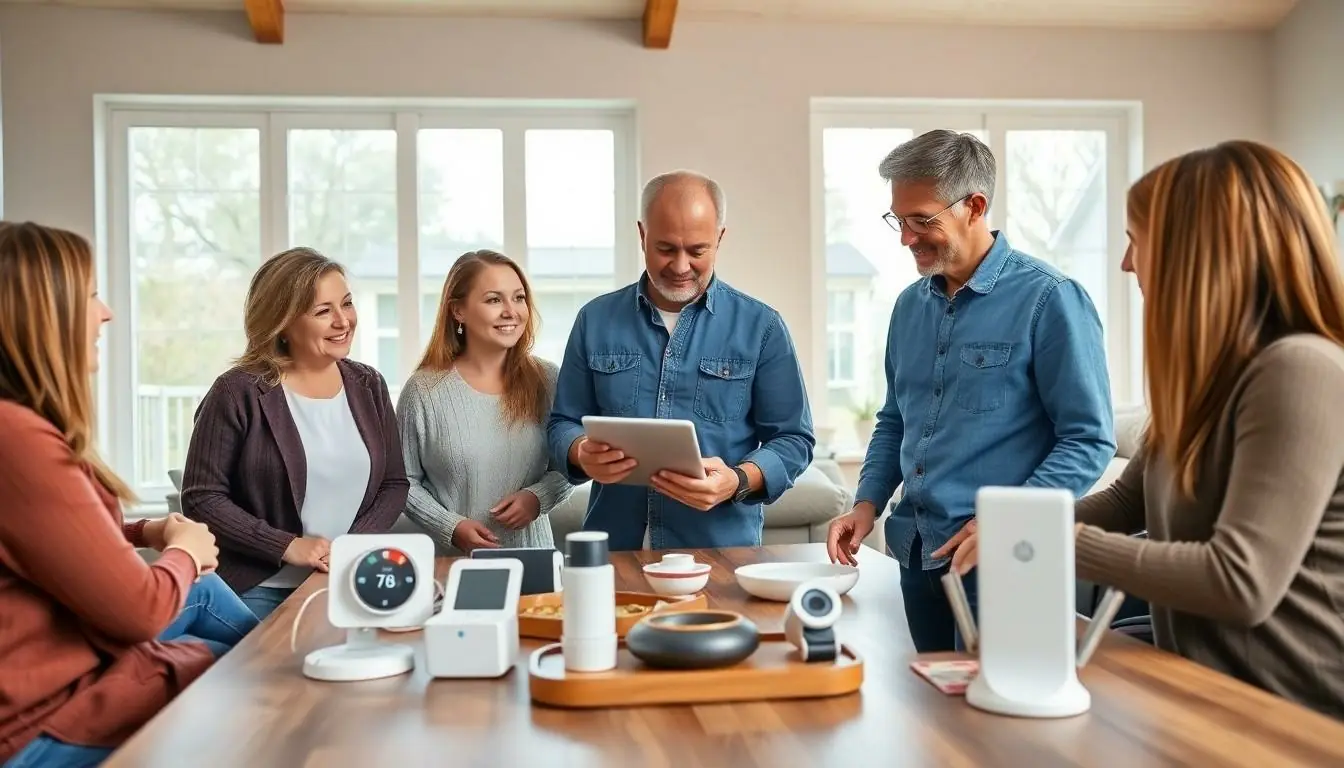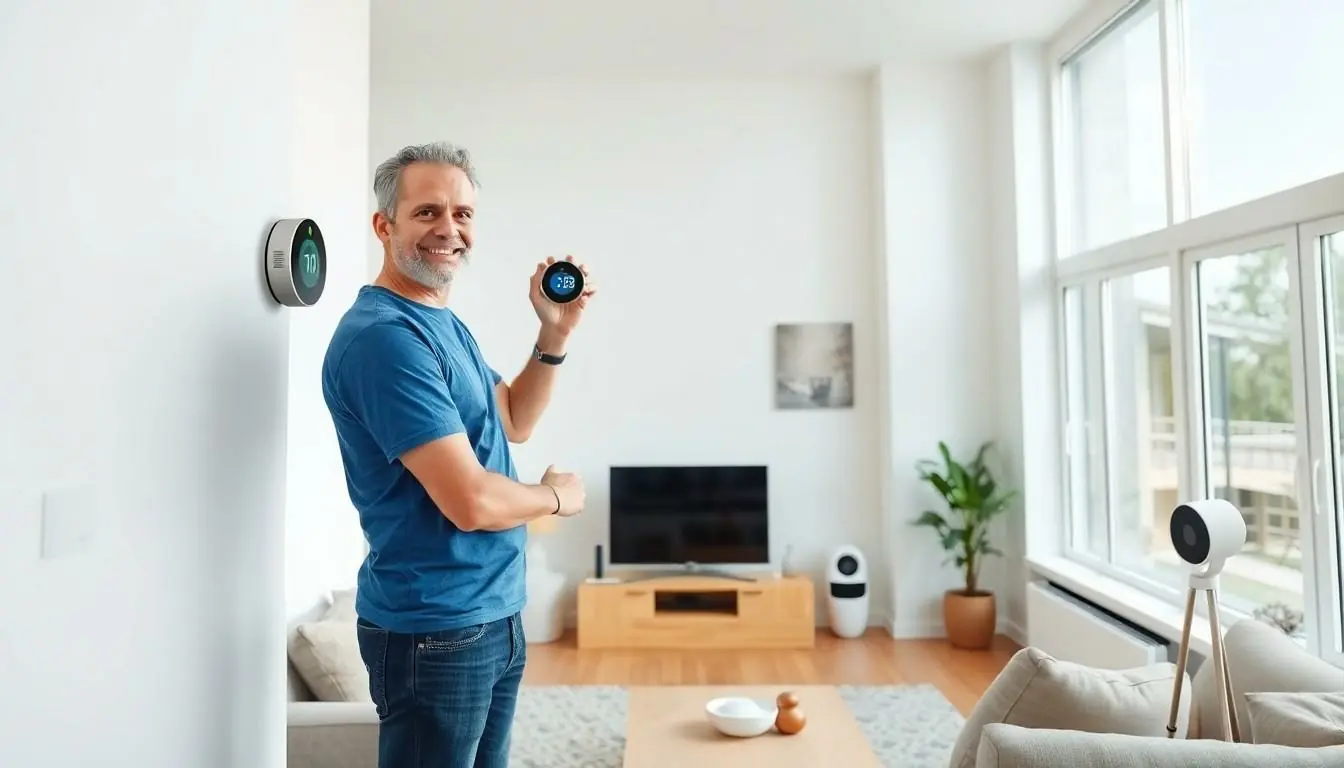Imagine walking into your home and having the lights dim, the thermostat adjust, and your favorite playlist start playing—all without lifting a finger. Sounds like something out of a sci-fi movie, right? Welcome to the world of smart home automation, where your home becomes your personal assistant, catering to your every whim.
Table of Contents
ToggleOverview of Smart Home Automation Installation
Smart home automation installation enhances daily living by integrating technology into residential spaces. This system allows users to streamline various tasks through automation and remote control.
Benefits of Smart Home Automation
Smart home automation offers multiple advantages, including increased convenience and energy efficiency. Homeowners control appliances, lighting, and security systems remotely, reducing the time spent on daily chores. Energy-saving options like scheduling thermostats and optimizing lighting patterns substantially lower electricity bills. Enhanced security features also protect homes, with systems that include surveillance cameras and smart locks. Furthermore, the ability to customize settings for personal preferences creates a tailored living environment.
Common Features of Smart Home Systems
Several features define smart home automation systems, making them user-friendly and efficient. Compatibility with voice assistants enables easy control through simple commands. Smart lighting systems adjust brightness automatically based on natural light availability. Climate control features allow real-time adjustments to heating and cooling systems. Additionally, integrated security options monitor home entrances and notify users of any suspicious activity. Smart appliances like refrigerators and washing machines enhance daily tasks with automation and remote monitoring capabilities.
Planning Your Smart Home Automation Installation


Planning ensures a smooth smart home automation installation process. Key elements include evaluating specific needs and managing installation costs.
Assessing Your Home’s Needs
Identifying individual preferences streamlines the assessment process. Prioritize which features enhance convenience, such as automated lighting or climate control. Evaluate existing devices for compatibility with smart systems. Homeowners benefit from examining areas that require security improvements, like entrances and windows. Assessing these needs helps tailor the automation to specific lifestyles and daily routines. Understanding unique requirements establishes a foundation for effective technology integration.
Budgeting for Installation
Setting a budget early on aids in managing expenses. Consider installation costs for smart devices, including security cameras, smart locks, and lighting systems. Factor in installation services if DIY projects feel overwhelming. Allocate funds for ongoing subscription services, especially for cloud storage or security monitoring. Researching different products can uncover various price points, allowing for flexibility in the budget. Balancing quality and cost ensures homeowners get the most value from their smart home investment.
Choosing the Right Devices
Selecting the right devices for smart home automation involves understanding available technologies and ensuring seamless compatibility.
Popular Smart Home Technologies
Smart appliances, security cameras, and smart lighting define popular technologies in this market. Voice assistants like Amazon Alexa and Google Assistant enhance interaction with these devices. Smart thermostats offer efficiency by learning user preferences and optimizing energy use. In addition, smart locks provide enhanced security and remote access to homes. Integrating these devices creates a comprehensive smart home network, promoting automation and convenience. Each device contributes to a more comfortable living environment.
Compatibility Considerations
Ensuring compatibility among devices is critical for a successful installation. Homeowners should check whether the chosen devices support the same communication protocols like Zigbee or Z-Wave. Additionally, confirming that devices integrate with existing home networks prevents connectivity issues. Reviewing manufacturers’ specifications and compatibility lists aids in making informed decisions. Prioritizing reliability and brand reputation helps maintain a smooth user experience. Investing time in this research saves future headaches and ensures a cohesive smart home system.
Installation Process
Smart home automation installation involves several key steps, whether opting for a DIY approach or hiring professionals. Each method offers distinct advantages, catering to different skill levels and preferences.
DIY vs. Professional Installation
Choosing between DIY and professional installation depends on comfort with technology and the complexity of the setup. DIY enthusiasts enjoy the challenge and potential cost savings associated with self-installation. With straightforward systems, homeowners can often complete setup without assistance. On the other hand, professional installers provide expertise and efficiency, ensuring devices are configured correctly and integrated seamlessly. For more complex systems, such as those requiring extensive wiring or multiple components, opting for a professional may prove beneficial.
Step-by-Step Installation Guide
A step-by-step installation guide streamlines the process of setting up smart home devices. First, gather all necessary tools and components, ensuring compatibility with existing systems. Secondly, follow the manufacturer’s instructions for each device, connecting them to the home network and power source. Thirdly, use smartphone applications to facilitate device configuration, which often includes naming devices and setting preferences. Next, test each device to confirm proper functionality, making adjustments as needed. Lastly, consider creating automation routines that enhance convenience, such as scheduling lights to turn on at sunset or adjusting thermostat settings automatically based on occupancy.
Maintenance and Troubleshooting
Maintaining a smart home automation system ensures optimal performance and longevity. Regular attention helps identify potential issues before they become significant problems.
Regular Maintenance Tips
Start with routine checks of device connectivity to ensure all components communicate seamlessly. Keeping software and firmware updated protects the system from vulnerabilities and enhances functionality. Clean smart devices as dust and debris can interfere with sensors and cameras. Schedule testing of automation routines periodically to confirm they work as intended. Lastly, document any changes made to the system to streamline future troubleshooting.
Common Issues and Solutions
Connectivity problems often arise when devices lose connection to the home network. Restarting the router usually resolves this issue. Device compatibility issues might emerge when integrating new components into an existing system. Consulting manufacturer specifications can clarify compatibility. If smart devices do not respond to commands, checking their power sources is crucial. Malfunctioning sensors can result from obstructions or misalignment. Realigning or clearing the sensor area generally resolves these concerns.
Smart home automation installation offers homeowners an incredible opportunity to enhance their living spaces with convenience and efficiency. By carefully planning and selecting the right devices, they can create a cohesive system that meets their unique needs. Whether opting for a DIY approach or hiring professionals, the installation process can be straightforward and rewarding.
Regular maintenance and troubleshooting are essential for keeping these systems running smoothly. By staying proactive and informed, homeowners can maximize their investment in smart technology. Ultimately, embracing smart home automation not only simplifies daily tasks but also contributes to a more secure and energy-efficient home.



